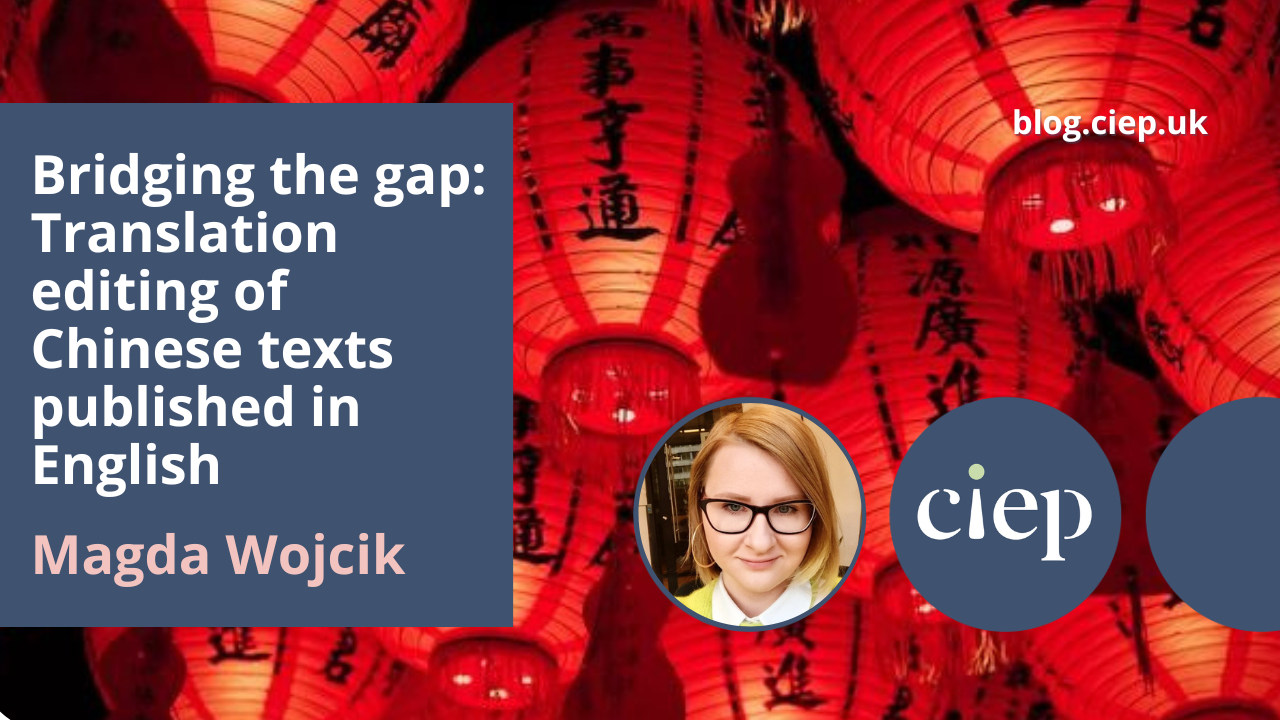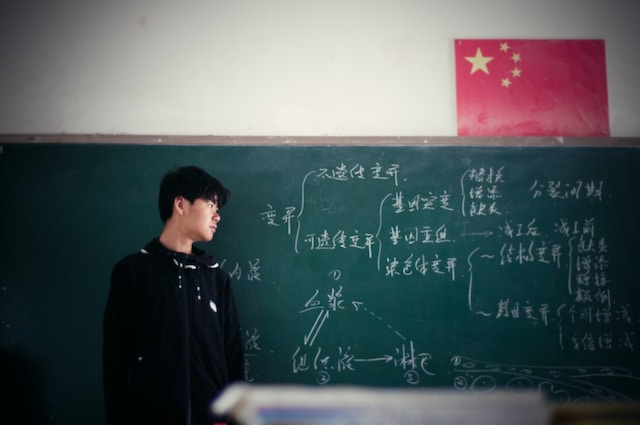In this post, Magda Wojcik considers some of the challenges in editing text that has been translated from Chinese to English.
Translation editing has a dual function when preparing a text for publishing. It performs the function of conventional copyediting, to ensure the text is clear, consistent and correct. It also provides harmony between the message, style and tone of the translated and original versions of the text.
Achieving such unity between two languages from the same language group spoken on the same continent may be easier. However, translation editing becomes more complex when the original (source) and the target (translated) languages differ profoundly in how they express, for example:
- grammatical gender systems
- time dependence
- directionality
- physical attributes such as colours.
This blog post explores the process of translation editing a text written in putonghua, which is the standard modern Chinese of the People’s Republic of China (PRC), for publication in English. Putonghua is one of the localisations of Mandarin Chinese, alongside those spoken in Taiwan and Singapore. In this post, the term ‘Chinese’ is used to refer to putonghua. Regarding English, for the sake of simplicity, this post does not delve too much into its complexities and variations.
Chinese vs English: How do they differ?
In (a very simplified) summary, Chinese expresses spatial and physical attributes and time dependence (including tenses, grammatical gender systems and numbers) differently from Indo-European languages (of which English is one). And unlike a Latin-based alphabet, Chinese uses a logographic writing system. In other words, each character represents a specific word or concept that can function as a standalone word or component of a word.
So what does that mean in practice? Let’s have a look at some simple examples.
Directionality and time
In Chinese, time progresses vertically rather than horizontally. So instead of thinking about the past as being ‘behind’ us, it is ‘above’ us; instead of thinking about the future as being ‘in front’ of us, it is ‘below’ us. For example, the character xia conveys not only ‘down’ or ‘below’ but also ‘next’. Likewise, shang denotes ‘up’, ‘above’, and ‘previous’. This distinctive understanding of time in the Chinese language, and its connection to spatial orientation, may present challenges in translation editing.
Colours
Some words in the Chinese language have been transforming, potentially aligning more with the Indo-European speaker’s understanding. For instance, modern Chinese distinguishes between blue (lan) and green (lü). However, a word that predates them both – qing, signifying blue-green – is also still in use. This does not mean that blue and green (as distinct colours) do not occur in Chinese-speaking contexts but may be conveyed (and perceived) differently, not necessarily as distinct shades.
Numerals
Separating every three digits with a comma or a period is common in many Indo-European languages and enhances readability and comprehension. For instance, five hundred million (500,000,000) separates three clusters of three-digit groups. In contrast, Chinese divides numbers into groups of four. The character wan represents the value of ten thousand, and yi means a hundred million. So five hundred million is expressed by placing the number five (wu) in front of the hundred million (wu yi). While China uses the international numeric system with three-digit groupings and Arabic numerals, wan and yi remain prevalent and may influence how Chinese speakers convey numerical values.
What about translation editing?
These simple examples may demonstrate that language and how we think about and perceive the world may be intricately intertwined and mutually influence each other. Aside from communication, people use language to think. How the language is structured, with its syntax and specific logical rules, may affect how speakers of different languages perceive the world and convey their thoughts (Casasanto 2008). And this is when translation editing and its components of transcreation and language localisation come into play.
Localisation ensures that the target audience will understand the text’s terminology, cultural references and style carried over from the original text. Transcreation complements localisation and ensures that the translated text accurately conveys the message and tone of the source text.
These processes are critical in translation editing text from one distinct language to another. However, considering them is essential even for texts published in the same language spoken in different locations. For instance, Spanish speakers from Colombia and Spain may not resonate with the same references to a brand of sweets or a national newspaper in a text because these references are absent from their corresponding socio-cultural contexts. And so many other idiosyncrasies relevant to location and culture may need to be adapted in the localisation process to resonate with the target audience successfully.
Localisation: What to do with Chinese idioms in English?
An example of such idiosyncrasy is Chinese four-character idiomatic expressions (chengyu). These are the dominant form of Chinese idioms, comprising nearly 90% of those used today in speech and writing (Xu 2006). They reflect complex meanings drawn from literature and culture using four characters (or four syllables), which may take a paragraph to explain in English.
An example of such chengyu is ‘drawing legs on a snake’ (hua she tian zu; lit. ‘draw snake, add feet’). It signifies adding unnecessary or excessive elements to an already complete or perfect thing. When translated word for word, it may appear entirely obscure to a speaker unfamiliar with the context of Chinese philosophy and literature.
Hua she tian zu derives from one of the Zhuangzi stories, a collection of Daoist essays dating back to the fourth century BC. It describes a talented painter participating in a painting competition.
In the story, the first competitor to complete a snake drawing was to be the winner. The painter who finished first decided to add legs to his snake in an attempt to showcase his skills, technically making it into a lizard instead. Thus, he did not win because by making the addition, he missed the brief.
In this case, the translation editor could ensure effective localisation and transcreation by referring to an equivalent British English idiom familiar to the audience. For instance, it could be ‘gilding the lily’, which originates from Shakespeare’s play King John. Alternatively, the translation editor could ensure the text describes the concept to the reader on a more abstract level without referring to the snake, legs and painter.
Conclusion
Translation editing plays a vital role in bridging the gap between Chinese texts and their English translations. The complexities arising from differences in grammar, expressions and cultural nuances require careful consideration during the editing process. By understanding the intricacies of both languages and cultures, translation editors can bring Chinese texts to life in English while preserving their intrinsic meaning and engaging English-speaking readers.
The unique features of the Chinese language, such as spatial and temporal orientation, a logographic writing system, and numerical representation, pose specific challenges in translation editing. Language and thought are intricately intertwined, influencing how we perceive the world and convey our thoughts. Therefore, localisation and transcreation are essential components to ensure that the translated text accurately conveys the message and tone of the source text while catering to the target audience’s understanding and cultural context.
In this journey of translation editing, it is crucial to balance staying true to the original text with making it accessible to the target audience. And as we navigate the complexities, we must remember not to draw legs on a snake.
References
Xu, SH (2006). Proximity and complementation: Studies of the formation mechanism of idioms from cognitive point of view (II). Jinan daxue huawen xueyuan xuebao [Journal of College of Chinese Language and Culture of Jinan University], (3): 33–41.
Casasanto, D (2008). Space for thinking. In P Calvo and P Gomila (eds), Handbook of cognitive science: An embodied approach. Amsterdam: Elsevier, 641–52.
About Magda Wojcik
Magda Wojcik is an Intermediate Member of the CIEP who primarily works with non-fiction and academic authors. She is also a translation editor preparing texts translated from Chinese for publication in English. Before becoming an editor, Magda completed a PhD in Chinese literary history at SOAS, University of London.
 About the CIEP
About the CIEP
The Chartered Institute of Editing and Proofreading (CIEP) is a non-profit body promoting excellence in English language editing. We set and demonstrate editorial standards, and we are a community, training hub and support network for editorial professionals – the people who work to make text accurate, clear and fit for purpose.
Find out more about:
Photo credits: Chinese lanterns by Henry & Co; teacher in Chinese school by Yu Wei; both on Unsplash.
Posted by Sue McLoughlin, blog assistant.
The views expressed here do not necessarily reflect those of the CIEP.



